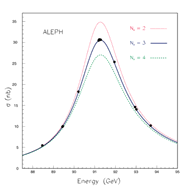
Normal matter in the world around us is built from two types of quark, called
"up" and "down", which form neutrons and protons. It also requires two
types of lepton: the electron and the electron-neutrino (which emerges for example in
radioactive decays). This pattern repeats itself in two heavier "generations",
each with two quarks and two leptons.
 |
Recent results from the LEP collider at CERN and from astrophysics show that there can be no more generations of this type. We do not know why there are only three generations, or why the one that forms the world about us was not enough. |
However, this puzzle may be linked with one of the mysteries of the Universe: Where did
the antimatter go?
Experiments in particle physics show that matter and antimatter are always created in
equal quantities, indicating that this should also have been so during the extremely
energetic conditions of the early Universe. But if that were so, why did the antimatter
not completely annihilate the matter, leaving only energy (photons) in the Universe? It
seems instead that there was some small but significant asymmetry between matter and
antimatter.
The only clue we have to the origin of this asymmetry comes from a breakdown of the
symmetry between particles and antiparticles known as CP-violation. Present understanding
of this effect is inextricably tied up with the existence of three generations. So far it
has been seen only in the neutral forms of particles called kaons, which contain
"strange "quarks of the second-generation, and are currently made at CERN with
protons beams from the SPS. The LHC, CERN's next machine, should readily produce particles
containing the heavier "bottom" quarks of the third generation. If the theory is
right, particles containing bottom quarks should also reveal the symmetry breaking effect
of CP violation.
![]()
© Copyright CERN
- Last modified on 1997-12-04